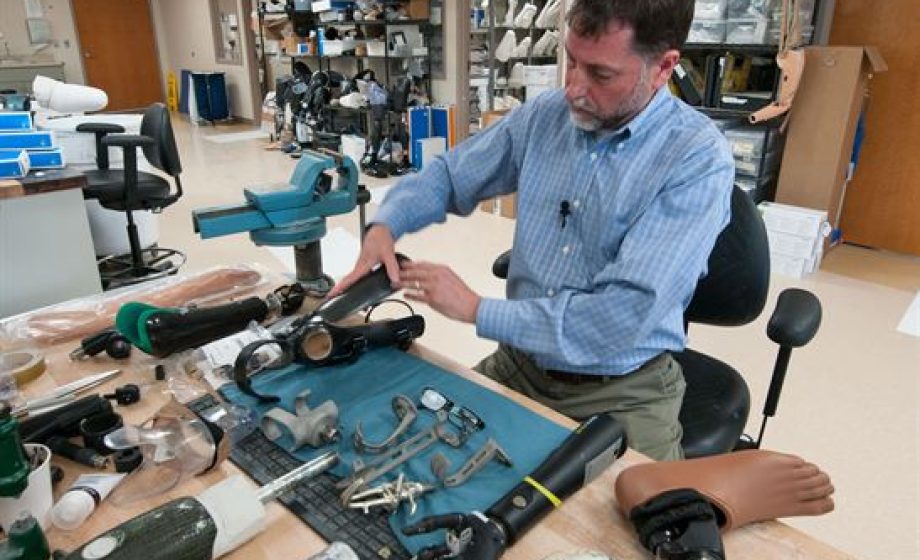
Last month, a man in the Netherlands was among the first people in the world to receive a new type of click-on robotic arm. This new, rare kind of robotic prosthetic clicks directly into the bone and is able to be controlled by the patient’s thoughts, meaning that it opens up a whole new range of movement for the patient in question. This works by re-routing nerves in the stump into existing, undamaged muscle groups in a process called ‘targeted muscle reinnervation’.
Within a few months these nerves grow into and throughout this new muscle group, allowing the brain to send ‘instructions’ along these nerves to a secure destination, where a sensor picks them up. So the brain says ‘move the arm up’ and this instruction follows the new path, going to the chest (for example) instead of the arm. A sensor in the chest reads and decodes the brain’s message of ‘move arm up’ and then remotely controls the bionic arm to move up. This is a drastic oversimplification, of course, but it does give a good overview of the process.
This is important because amputations are becoming more common, thanks to diabetes being rife in developed countries (54% of amputations are related to vascular disease) and a string of wars leaving large numbers of veterans with traumatic amputations, added to the number that happen due to accidents and incidents of trauma (45% of amputations). The other 1-2% of amputations per year are caused by cancers and other diseases.
When all is said and done – over 1 million people globally suffer an amputation per year. That is one every 30 seconds. It is among the most severe and most traumatic of injuries, changing a person’s life drastically and, until recently, irrevocably. Considering how devastating these injuries are, it is almost beyond belief that until recently efforts to rehabilitate them using modern bionic technology has been somewhat lacking. Fortunately, that is now changing.
Losing a limb is traumatic enough, but re-integrating into society as a fully functioning member is often extremely difficult. According to J. Chand Duncan PhD, conducting research on behalf of the Fernberg School of Medicine, people who suffer amputations are 1.5 times less likely to find employment as well as a study by Nellie Njambi Mugo which found that in many cases ‘amputated victims see themselves as unfit for the society anymore after amputation and people in the society also see them as members of [a] stigmatized group’. This is, of course, not everyone – however it does go to show that an amputation has a truly life-changing effect on any patient.
This is where mind-controlled robotic prosthetics come in as being incredibly important. A prosthesis socket is no longer needed and is instead replaced with a metal rod directly into the bone where the robotic prosthetic can be attached. This makes it easy to put on and take off, as well as avoiding skin problems common with older prosthetics.
Perhaps most important of all to any patient is the new and improved range of motion. The US Defense Advanced Research Projects Agency (DARPA) presented a robotic arm in late 2015 that can not only be controlled by the human brain but can also allow the human controller to sense what it touches. This exceptionally advanced device is connected by wires to the user’s motor cortex, which controls muscle movement, and sensory cortex, which handles the sensation of touch.
This DARPA arm was trialled by a 28 year old man who had been paralysed for more than a decade after his spinal cord was damaged during an accident. The technology allowed him to use his hand naturally, as well as detect when it was being touched. With a bit of practice, it swiftly became the most tactile and useful prosthetic yet. Later iterations have also removed the requirement for a body harness to assist in using the arm, knowing as the Modular Prosthetic Limb.
Much of the headway made in this field has been done by Revolutionizing Prosthetics, which is a project run by the aforementioned DARPA. Though the trials and articles are focused on disabled veterans, the research and achievements carry through very swiftly to public, civilian use.
These features will begin to appear in widely affordable iterations within the next 5 to 10 years. This isn’t just a matter of allowing amputees to regain control of their bodies without relying on others to complete precise tasks for them, but realistic-looking, realistic-moving hands can almost turn back the clock and allow the user to live their life as if nothing had happened. Soon, an amputated limb will be no more life-changing than a broken one.
European companies such as bebionic are now producing robotic hands so tactile and precise that one can hold a polystyrene cup with no worry of accidental damage to the vessel, whilst still being able to use the robotic hand to crush an empty can a few minutes later. The fingers on some models even flex when brushed against, simulating natural looking movement. These all come with a ‘Standard Glove’ – an advanced silicone ‘skin’ that can be slid over the arm – not unlike a reversal of the infamous arm cutting scene from Terminator 2. It might be a crass comparison, but it’s a helpful one for those unfamiliar with bionic technology.
Such a range of life-like limb replacements may be a cool piece of technology to the able-bodied, but to millions of disabled amputees it could mean a lifeline back to a self-sufficient, fully integrated lifestyle. With over 423,000 amputees in mainland France alone, this technology will be life-changing for a great many people with which augmented reality apps and self-driving cars cannot compare. Though there is great focus on the latest technological wonders to come from our onwards march of scientific and engineering advancement, let us not forget that it is the human impact of our technology that truly matters.

